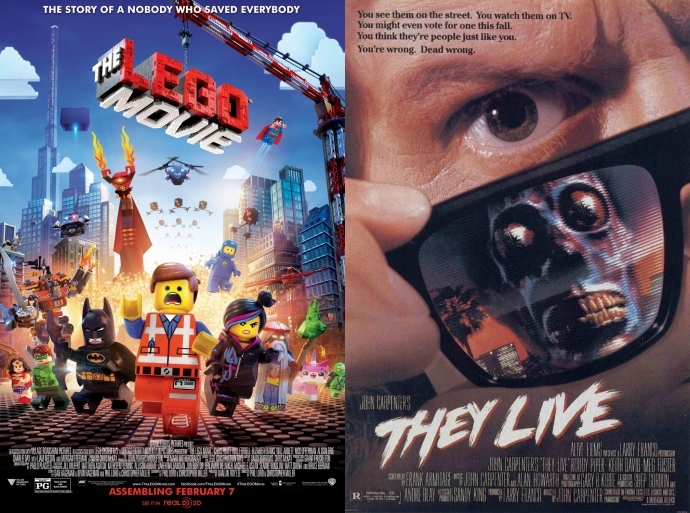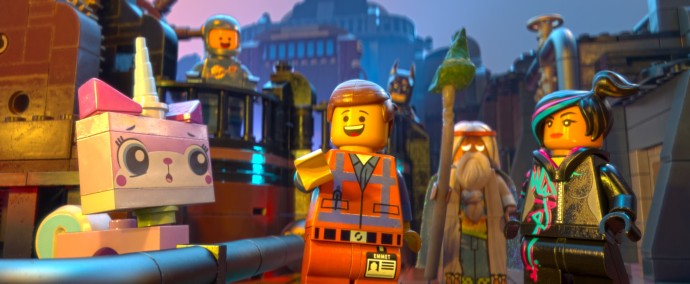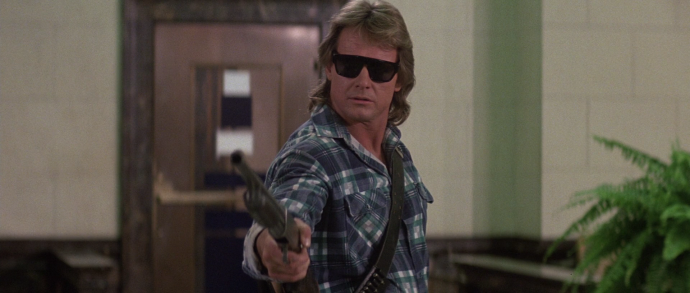
A generation after John Carpenter’s They Live quietly made waves to minor box office, its legacy as a cult classic and a sly critique of Reagan’s America has indirectly (or, perhaps, directly) influenced one of the most incongruous motion pictures possible.
The Lego Movie just finished its well-deserved third week at the top of box office, anchored by the film industry’s current romance with brand awareness and a family-friendly demeanor. Based on the iconic toy line, it was one of the least possible of its kind to see adaptation. Unlike Transformers or G.I. Joe, Lego has a broader ideology and no specific characters. The idea of The Lego Movie is an antithesis to the unlimited creativity that Legos promise, and the trailers—while they hinted at amusing elements such as the prescience of Batman as a supporting character and eye-popping visuals—was an easy sell for commercial audiences and children, but an alienating one some filmgoers. With Pitbull and Christina Aguilera’s obnoxious “Feel This Moment” blaring in the background as colorful action unspooled and one-liners rattled off, The Lego Movie looked amusing but annoyingly typical of the modern blockbuster.

Indeed, the film plays as such—if you are that nonchalant adult or child who takes movies for face value. 21 Jump Street, the hilarious previous film by directors Phil Lord and Chris Miller, was an indicator of the sublimely subversive anti-conformity The Lego Movie plays with. In the comedic reappraisal of the 1987-91 Fox cops-undercover-as-teens drama, Nick Offerman’s frustrated police chief explains the motivations behind the project, words that ring true with what was probably thought by many film fans upon finding out about The Lego Movie: “We’re reviving a canceled undercover project from the 80’s and revamping it for modern times. The people behind this lack creativity and they’ve run out of ideas, so what they do now is just recycle shit from the past and hope that nobody will notice.”
The Lego Movie is a triple-distilled relic of pop culture, but only at face value. Its self-awareness is unflinching, a delightful reawakening of the kind of pop-culture satire that always made Warner Bros.’ animation catalog smarter and funnier than what Disney had to offer. Celebrities and famous characters pop in and out of the picture the same way Bugs Bunny mingled with Bogie and Cagney and Plucky Duck and the Animaniacs tried to scheme their ways into Steven Spielberg’s inner circle. One of its central characters, Benny, voiced aptly by Charlie Day, is a faded-out “1980’s spaceman” who is lost in his own time and frequently yells “Spaceship!” in hopes of creating an era-appropriate Space Shuttle.
Lord and Miller are also blissfully keen-eyed, almost frighteningly, to the virtues of its voice actors. Morgan Freeman voices Virtuvius, a God-like figure whose presence lives and dies on the actor’s universally recognizable voice. Liam Neeson’s evolution from prestige actor to something of a more esteemed Charles Bronson in Taken and other action films is characterized by a schizophrenic motorcycle cop whose head switches around from bumbling goody two-shoes to overly aggressive badass. A dab of nail polish remover wipes out Good Cop, leaving Bad Cop—an ostensible representation of the Neeson starring in Unknown and The Grey—the only persona, a possible sly wink at the Internet film community’s perception of Neeson’s career. Will Ferrell, voicing the megalomaniac villain Business, is established on the foundation of his brash, near-screaming line deliveries, which have established him as a formidable comedic talent on Saturday Night Live and in films like Anchorman and Step Brothers. Superman and Green Lantern are exploited by Lord and Miller to extend the terrific chemistry voices Channing Tatum and Jonah Hill had in Jump Street.
The Lego Movie‘s yellow-painted lead, construction worker Emmet (voiced by Chris Pratt), is a hapless average Joe from the Lego metropolis Bricksburg. He pays over $40 for coffee every morning and is routinely ignored by his co-workers, despite their mutual love of the looped hit song “Everything is Awesome.” The universally adored TV show in the city is Where are My Pants?, an embarrassingly one-joke sitcom that would hold its own against Bixby Snyder, RoboCop‘s “I’d buy that for a dollar!” heckler, or the intellectually diluted television of the 31st century in Mike Judge’s Idiocracy.

The sunny landscape of Bricksburg contrasts deeply with the dirty, hopeless 1988 Los Angeles that Nada (Roddy Piper) hitchhikes into at the start of They Live. After haggling the overcrowded unemployment offices for a job, he ends up in Emmet’s workline: construction. Upon discovering a box of Ray-Ban Drifter sunglasses, the uneven class struggle and emotionless media and politics are unclothed: generic, omnipotent statements of control over humanity. OBEY. MARRY AND REPRODUCE. STAY ASLEEP. CONSUME. SLEEP EIGHT HOURS. Even cash is uncovered to read THIS IS YOUR GOD.
Worst of all, however, is that not all people are humans: the sunglasses are able to expose skeletal aliens who Nada who look “like they fell in the cheese dip back in 1957,” or are “real fuckin’ ugly.” Suspicion escalates into violence, dragging Nada into an extraterrestrial conspiracy to bury Earth’s legacy via TV-satellite hypnotism. Amusingly, the robot minions of Business in The Lego Movie bear more than a passing resemblance to the “formaldehyde-faced” bureaucrats of Carpenter’s film, accentuated by their menacing teeth and eyes.

Nada’s discovery of the sunglasses in an abandoned box and Carpenter is one and done, onto the paranoia aspect. Meanwhile, Emmet’s acquisition of the Piece of Resistance is typical Joseph Campbellian nonsense. Lord and Miller write Emmet with full awareness of the formulaic truth of the Hero’s Journey paradigm: Vitruvius refers to Emmet as “the chosen one” as if we’ve been blissfully unaware of the Matrix films. Moreover, during the film’s first major action sequence, resistance fighter Wyldstyle (Elizabeth Banks) balks at Emmet, “Come with me if you want to not die!”—yet another direct callback, this time to the Terminator franchise, which James Cameron founded as the adventures of a genetic hierarchy of heroic prophets.
That luck of swindling the audience with the Hero’s Journey stretches further with the multitude of characters Emmet, Wyldstyle and Vitruvius meet along the way. Benny and a temperamental mythical feline named Unikitty (voiced by Alison Brie) come for the ride. Most notable of the bunch, however, is the presence of Batman, a satirically egotistical and brooding interpretation that reflects the dark, sullen cinematic guise of the famed character that’s carried through from Tim Burton’s 1989 film to the recent Christopher Nolan trilogy. Will Arnett’s voice work conveys the gravelly sneer of Michael Keaton, Kevin Conroy and Christian Bale just as convincingly as the real thing, except here, Lego Batman is riding off of a generation of “grim and gritty” summer blockbusters that reinvented the character. The absurdist portrayal makes for the funniest interpretation of the character since Adam West on the 1966-68 TV series—ironically, the work that left the comic-book crowd begging for a return to the Dark Knight’s bleak roots, only to bite the feeding hand by the time The Dark Knight Rises divided audiences in 2012.

Carpenter refutes the Hero’s Journey myth in They Live, abhorring it even. Nada is constantly distrusted by his co-worker Frank (Keith David) and only begrudgingly trusted by Holly (Meg Foster), the assistant director at a local cable TV station. Holly retaliates to Nada by throwing him off of her balcony and down a long hill, while Frank only concedes to the cause that aliens are taking over after the film’s infamous six-minute long back alley fight scene. Clearly, Nada is envisioned as an anti-yuppie outlaw, a modern-day Man with No Name that not only refuses to accept the societal norms of the alien conspiracy, he refuses to accept the rules of how to accomplish his goals via a modern story structure. Tension builds, but the character arc does not: if it did, the purpose of They Live would be worthless.
In the case of The Lego Movie, having Emmet directly parallel Nada would be alienating and contradictory to the kind of all-ages entertainment the film offers. Rather, because of the dominance of the supporting characters in The Lego Movie, Emmet shares more in common with Jack Burton, the wisecracking but witless protagonist of John Carpenter’s 1986 film, Big Trouble in Little China. Like Emmet’s instruction-abiding ethic, Kurt Russell’s performance as Burton is ostensibly the hero of the piece, but the superior intelligence and combat of his cohorts, Wang Chi and Egg Shen, render Burton less the hero than the Greek chorus, a village idiot whose voice bellows over the better judgment of his allies.
Emmet is “the one” who must become the “MasterBuilder,” but it is by chance and the hard work of his new-found friends that the journey progresses. His hard-thought idea for a “double-decker chair” is mocked and laughed off by his friends, while his problem-solving skills are fleshed out by the rest of the crew. Emmet is a less an action hero than a reaction hero, a quipping dreamer with a big heart and whose positive energy is the Rosetta Stone of what transpires around him, echoing the repeated lyrics of “Everything is Awesome”:
Everything is awesome
Everything is cool when you’re part of a team
Everything is awesome
When we’re living our dream
Keeping in line with the loner status of Nada, They Live does not exactly go for the content of “Everything is Awesome.” Carpenter called Roddy Piper “the toughest guy I’ve ever met” in a November 1988 Starlog article, a statement that goes hand in hand with the kind of selective zeal The Lego Movie‘s voice cast was drawn together with. Carpenter knows and adores the fact that the only hope for humanity is a professional wrestler, at that one known for his colorful, mustache-twirling, antagonizing the likes of Hulk Hogan and Cyndi Lauper. Nada is an avatar for the disgust with the post-Oliver North stretch of the Reagan administration and the power of the Almighty Dollar—which just happens to play right towards the center of Business’s “Taco Tuesday” media blitz for world domination, a Trojan-horse scheme to “freeze” the Lego world’s citizens and ruin their hopes for creativity.
To see a violent, R-rated purge of sociopolitical angst and an innocuous animated comedy brought together by a broad but common theme is a rare thing to see in film, let alone from different eras. One is condemning the most socially conservative era of moral unity since the 1950’s. The other is a chaotic and joyous middle finger at the expectations of Hollywood’s recyclable machine, and yet together the message of both films becomes clear: not one person, idea, place or thing can be alike. If they end up alike, humanity will lose its identity into an abyss of Orwellian dread and despair. Revolution is not necessary to keep the power of imagination alive. It can be contained and expressed through our collective minds. Enlightenment may be one of our top reasons to view or read any text, but the final truth is simple: the highest power of art is escapism.